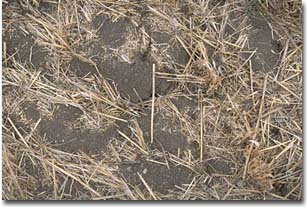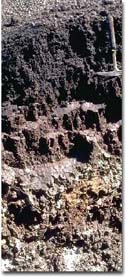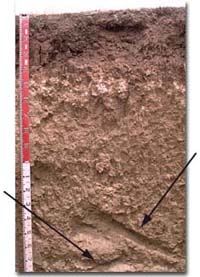Soil Glossary S-Z
A-C | D-G | H-R | S-Z | References | Soil Homepage
SALINAS: Depressions holding salty groundwater that are often evaporative.
SALINITY: A measure of the total soluble salts in a soil. A saline soil is one with an accumulation of free salts at the soil surface and/or within the profile affecting plant growth and/or land use. It is generally attributed to changes in land use or natural changes in drainage or climate, which affects the movement of water through the landscape. Salinity levels of soil or water can be tested using Electrical Conductivity (EC).
SAPROLITE: Decomposed rock that has maintained characteristics that were present as an unweathered rock.
SEGREGATIONS: Accumulations of minerals in the soil due to the concentration of constituents. They occur as a result of chemical or biological action. They can develop in situ by either current or relict pedogenic processes (McDonald et al., 1990).
Segregations are described by their nature, abundance and form:
- Nature: calcareous (carbonate), gypseous (gypsum), manganiferous (manganese) and ferromanganiferous (iron-manganese).
- Abundance:
| Very few | <2% | |
| Few | 2-10% | |
| Common | 10-20% | |
| Many | 20-50% | |
| Very many | >50% |
- Form:
| C | concretions | Spheroidal formations (concentric in nature). | |
| N | nodules | Irregular rounded formations (not concentric or symmetric). Can have a hollow interior. | |
| F | fragments | Broken pieces of segregations. | |
| X | crystals | Single or complex clusters of visible crystals. | |
| S | soft segregations | Finely divided soft segregations. They contrast with surrounding soil in colour and composition but are not easily separated from the soil as separate bodies. |
SELF-MULCHING: A structural condition of soils where there is a high degree of pedality. The peds naturally fall apart as the soil dries to form a loose surface mulch. Some Vertosols have self mulching surface soils.

A self-mulching surface soil of a Grey Vertosol near Horsham.
SEMIAQUIC: Soils with short term saturation in the B Horizon. This term is used as a definition for the Podosol Order in the Australian Soil Classification (Isbell, 2002) .
SESQUIC: A sesquic B Horizon (or Bs Horizon) is where iron compounds are strongly dominant or codominant with aluminium and there is little evidence of organic matter. This term is used as a Great Group definition for the Podosol Order in the Australian Soil Classification (Isbell, 2002).
SESQUIOXIDE: An oxide containing 3 atoms of oxygen with 2 atoms of some other substance e.g. AL2O3.
SILICEOUS SANDS: These are a broad group varying in colour but are characterised by their uniform sand to clayey sand texture, deep profiles, massive single-grain structure and the absence of any distinct horizons except for a minimal accumulation of organic matter in the A1 horizon, making it slightly darker. This horizon can be absent when there is no vegetation to hold it in place.
SLAKING: The break down of soil aggregates when immersed in water into smaller sized micro-aggregates. These aggregates may subsequently disperse.
| SLICKENSIDES: Subsoil structural features which develop as a result of two masses moving past each other, polishing and smoothing the surfaces. These are common in Vertosols. | |
 Slickensides in a Vertosol from the Corangamite region. |  |
SODICITY: Is a measure of exchangeable sodium in relation to other exchangeable cations. It is expressed as the Exchangeable Sodium Percentage (ESP). A sodic soil contains sufficient exchangeable sodium to interfere with the growth of plants, including crops. A soil with an ESP greater than 6 is generally regarded as being a sodic soil in Australia (Northcote and Skene, 1972). ESP levels are further classified in the Australian Soil Classification (Isbell, 2002). See Sodic Soils on the VRO website for more information.
SODICITY INDEX: There are three ratings for soil sodicity and they are as follows:
| 0-5 | Non-sodic |
| 5-15 | Sodic |
| 15 + | Strongly Sodic |
SODIUM ADSORPTION RATIO (SAR): The proportion of sodium in the adsorbed layer, which is held in the pore fluid of the clay. This identity is calculated from the soluble cations present in the supernatant liquid and is expressed as
| sodium |
| [ calcium + magnesium ]½ |
| 2 |
The SAR of a soil extract is generally preferred as a sodicity index rather than Exchangeable Sodium Percentage (ESP) because it is more easily determined (Mitchell, 1976). Also, ESP values can vary depending on whether Cation Exchange Capacity (CEC) or the sum of the major cations is used as the divisor.
SODOSOL: A Soil Order of the Australian Soil Classification (Isbell, 2002). These soils have a clear or abrupt textural change between the A Horizons and B Horizons. The top 20 cm of the B2 horizon is sodic and is not strongly acid. Soils with a subplastic B2 horizon are excluded.
SODOSOLIC: Relates to Hydrosols in the Australian Soil Classification (ASC) - that have a clear to abrupt textural B horizon which is sodic and not strongly acid in the major part of the upper 0.2 m of the B2 horizon is not strongly acid.
SOIL FERTILITY: Soil fertility is defined by the Soil Science Society of America as "the status of a soil with respect to the amount and availability to plants of elements necessary for plant growth". The capacity of a soil to hold the major cations, Calcium, Magnesium, Potassium and Sodium (and Hydrogen, Aluminium and sometimes Manganese in acid soils) is widely used for agricultural assessment. It is a measure of the general fertility of the soil and is particularly important in irrigated soils, when cations would otherwise be leached out of the root zone (Soil Science Society of America, 1973), (Baker and Eldershaw, 1993).
SOIL TYPE: This is a basic unit for classifying and mapping soils. It groups soils where profiles vary within defined, narrow limits. A soil type developes from a common parent material and following the U.S. definition, has areas as well as depth.
SOLODIC SOIL: A Great Soil Group, (Stace et al., 1968) classification.These soils have a strong contrast between the texture of the A and B horizons and a bleached A2 horizon (which may contain a few sesquioxidic nodules). The A Horizons are usually acidic and the B Horizons are alkaline grading to strongly alkaline at depth. The B horizon has medium to coarse blocky peds (which may be arranged in a coarse columnar fashion). These soils are typical in semi-arid and subhumid climatic zones and tend to be very dense soils with low permeability. The difference between solodic soils and solodized solonetz soils occurs in the structure of the B horizon: solodics have a medium to coarse blocky structure whereas solodized solonetz soils have a coarse columnar structure with clearly defined domes on the tops of the columns.
SOLODISED SOLONETZ: A Great Soil Group (Stace et al., 1968) classification. These soils are identical to solodic soils except for the structure of the B Horizon. Solodics have a medium to coarse blocky structure where as solodized solonetz have a coarse columnar structure with clearly defined domes on the tops of the columns.
SOLONETZ: A Great Soil Group (Stace et al., 1968) classification. Typically, there is weak differentiation between the A Horizons. The A2 horizon may be sporadically bleached just above the clay subsoil. There is an abrupt boundary and a strong texture contrast between the A and B Horizons. Surface soils are typically neutral to alkaline with a strongly alkaline subsoil. The subsoil clays are high in sodium and magnesium ions and usually have a prismatic structure.
SOLONIZED BROWN SOILS: A Great Soil Group (Stace et al., 1968) classification. These soils have large amounts of calcium and magnesium carbonate in the profile. Soil properties show a gradual change down the profile. The most evident is the increase in carbonates with depth. Texture also becomes finer with depth and the pH changes from a neutral/slightly alkaline surface horizon to an alkaline subsoil. The soluble salt content of the subsoil also increases significantly. Dark manganiferous nodules can also occur in the subsoil.
SOLOTH: A Great Soil Group, (Stace et al., 1968) classification. Similar to a solodic soil but acidic throughout the profile. Tends to be a more typical soil of the humid regions where the exchangeable cations in the B Horizon of the solodised soils have been leached out.
SOLUM: A and B horizons that have developed from the parent material by the processes of soil formation.
STRUCTURE: Describes the way the soil particles are arranged to form soil peds. Peds are units of soil structure that are separated from each other by natural planes of weakness (McDonald et al., 1990). They differ from clods which are formed as a result of soil disturbance such as ploughing.
Structure is defined by three characteristics:
- GRADE measures the degree of development and the distinctiveness of the peds. It varies depending on the soil water status and can be divided into five groups:
- single grain, loose and incoherent mass of individual particles;
massive, when displaced the soil separates into fragments which may be crushed into ultimate particles;
weak, peds indistinct;
moderate, peds are well formed and visible but not distinct in undisplaced soil, adhesion between peds is usually firm and when displaced between one third and two thirds of the soil material consists of peds, and;
strong, peds distinct in undisplaced soil, adhesion between peds is firm, and when displaced, two-thirds or more of the soil material consists of peds.
- SIZE is measured and described based on the average least dimension of the peds. A guideline is provided in the Australian Soil and Land Survey Field Handbook (McDonald et al., 1990) pages 126 to 131.
- TYPE of structure has been described throughout the glossary. For example, platy, prismatic, columnar, angular blocky, subangular blocky, polyhedral and lenticular.
A number of different grades and sizes of peds may occur within a horizon. This is referred to as compound pedality. An example of this is when prismatic structure breaks down into smaller blocky peds.
| SUB-ANGULAR BLOCKY STRUCTURE: Similar to angular blocky except the peds are bound by six faces intersecting with round edges (i.e. like a rounded cube) (McDonald et al., 1990). |  |
SUBNATRIC: In these soils a major part of the top 0.2 m of the B2 Horizon has an ESP between 6 and less than 15. These soils are considered to be sodic. Used as a Great Group definition for Sodosols in the Australian Soil Classification (Isbell 2002).
SUBPLASTIC: These soils have a consistence or textural property (after kneading for 1-2 minutes) that suggests less clay sized particles than the soil actually contains. A subplastic soil increases in field texture after 10 minutes of kneading i.e. the soil texture becomes more clayey and harder to work. It is a feature of relatively deep subsoils and much energy is required to break down the soil aggregates. Also, these soils do not shrink/swell greatly when wet (McDonald et al., 1990).
SUBSOIL: The B Horizon and its subdivisions, excludes the C Horizon.
SUBSOILing: Deep ploughing into the subsoil.
SUBSTRATE OBSERVATION TYPES:
| P | Soil pit |
| E | Existing vertical exposure |
| C | Relatively undisturbed soil core |
| A | Auger boring |
| O | Outcrop |
SUPRACALCIC Term use to classify soils using the Australian Soil Classification (Isbell 2002). Refers to soils with a calcareous horizon containing 20-50% of hard calcrete fragments and/or carbonate nodules or concretions and/or carbonate-coated gravel.
SURFACE CRUST: A massive or weakly structured often lamina layer that is lighter in texture than the underlying pedal clay. This soil condition should not be confused with self-mulching behaviour (McDonald et al., 1990).
TENIC B HORIZONS: This horizon has a weakly developed B Horizon in comparison with the overlying A Horizon and other horizons below, in terms of texture, colour, structure and/or presence of segregations (including carbonate). This term is used in the Australian Soil Classification (Isbell, 2002).
TENOSOLS: Soil Order of the Australian Soil Classification (Isbell, 2002). These soils generally have weak pedological organisation throughout the profile apart from the A Horizon. Tenosols display more profile development than Rudosols and may include a weakly developed B Horizon with 15% clay or less.
TEXTURE (FIELD): Field texture is determined by measuring the behaviour of a small handful of soil grains (<2 mm in size) when moistened and kneaded (1-2 minutes) until it does not stick to the hand. It provides an estimate of the relative amounts of coarse sand, fine sand, silt and clay size particles. Soil texture influences many soil physical properties such as water holding capacity and hydraulic conductivity. Numerous soil properties affect the determination of texture such as type of clay minerals, organic matter, carbonates, etc. Texture is determined by the behaviour of the moist bolus and length of the ribbon when sheared between thumb and forefinger, as described by (McDonald et al., 1990).
TOTAL SOLUBLE SALTS (TSS): A measure of the soluble salts in the soil (mainly sodium chloride, sulphate and carbonate). It is a calculated value derived using the Electrical Conductivity (EC) reading where Total Soluble Salts % = Electrical Conductivity (dS/m) x 0.33. TSS needs to be considered relative to profile water movement.
TOXICITY: Refers to a harmful effect on a plant (or animal) from the alteration of an environmental factor. A toxicity will manifest as damage to an organisms and may lead to early death.
Most elements can be toxic to plants if present in large enough quantities in soil.
UNIFORM PROFILE FORM: A Primary Profile Form of the Northcote Factual Key Classification, (Northcote, 1979). These soil profiles have limited, if any texture change throughout the profile. There is generally no textural boundaries found within the uniform profile, except for possibly a surface crust. Uniform soils are given the notation "U".
VERTIC PROPERTIES: This term is used to describe a subsoil with a field texture of 35% or more clay that experiences significant shrinking and swelling, resulting from drying and wetting. This often results in the development of features such as surface cracking and gilgai formation. Evidence of vertic properties include the presence of slickensides and/or lenticular peds in the subsoil. The amount of swelling is dependent on the type of clay present. These features are of significant importance for engineering purposes such as road construction. This term is used as a Subgroup definition for a number of Soil Orders in the Australian Soil Classification (Isbell, 2002).
VERTOSOLS: A Soil Order of the Australian Soil Classification (Isbell, 2002). These are clay soils with shrink/swell properties that display strong cracks when dry and have slickensides and/or lenticular structural aggregates at depth.
VESICULAR: Blisters of burst bubbles under the crust of the soils surface Factual Key.
WATER REPELLENT: Soils that are fairly resistant to wetting (from a dry state). It is a condition usually associated with sandy surface horizons and is generally caused by an organic coating on sand grains.
WILTING POINT: The water content of the soil where the plant is no longer able to extract it and therefore the plant wilts (Cass, 1999). Wilting point is measured at approximately pF 4.2.


